 |
Explorers and Exiles
Alan Mathison Turing was conceived in what is now Chhatrapur, Ganjam, Orissa, India, a town on the Bay of Bengal.
See these pictures of computer learning in the Ganjam of 2005, described as a economically backward area.
In 1911 this was at the extreme northern end of the Madras Presidency of British-controlled India. His father Julius Mathison Turing was a government official, and his Irish-born mother Ethel Sara (née Stoney) had also spent much of her life in India, where her father was an engineer.
From the start, Alan Turing was an outsider, yet born at the heart of the British Empire at its zenith.
Genealogy of the Turing family.
|
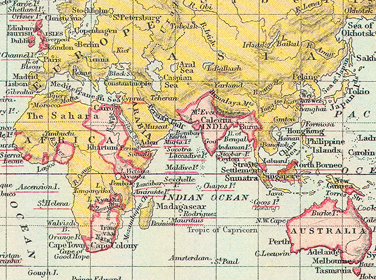
The Turing world of 1912
|
He was born in a nursing home in Paddington, London on 23 June 1912. It was then called Warrington Lodge.Now it is the
Colonnade Hotel, in Warrington Crescent, London W9.
Street map here. This building was a nursing home from 1885 to 1935, but then became the Esplanade Hotel, and was used by many refugees from Europe.
In 1938 Sigmund Freud, as a refugee from Vienna, stayed there briefly.
|
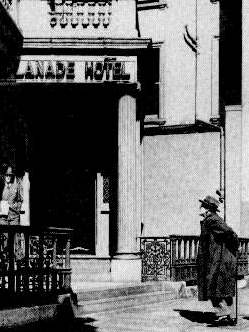
Freud outside the hotel in 1938. |
| Alan Turing was to become, like Freud, an explorer of the mind. But his life would not make him famous like Freud. And it was to lead to a different kind of exile. |
The Blue Plaque and other Birthday Events
The American Mathematical Society marks Alan Turing's birth as one of the great June events in mathematical history.
On 23 June 1998 I had the honour of unveiling an
English Heritage blue plaque on the birthplace. See my Oration.
On 23 June 2001 the sculpture of him in Sackville Park, Manchester was unveiled.
In June 2002 his 90th birthday was celebrated at Lausanne. 23 June 2012 was the climax of the Alan Turing Centenary Year, celebrated particularly at Cambridge and Manchester.
|
|
Fosterchild of the Empire
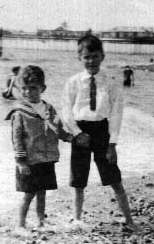
Alan and John Turing.
|
Alan and his elder brother John did not see much of their parents. Their father was in the Government of the Madras Presidency until 1926.
They were left in the care of a retired Colonel in Hastings.
In early 1922 the nine-year-old Alan was sent to a preparatory boarding school, Hazelhurst, in Sussex.
|
By chance he was captured by a national press photographer at Waterloo Station on his way back to school. See the photograph in the Turing archive.
(The Times excitedly claimed in 2009 to have a new photograph of him, but it was, in fact, this same one.)
|
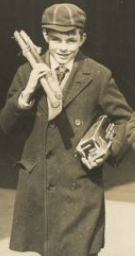 |
|
The Inspiration of Nature
He dreamed his way through, doing chemistry experiments of his own. Once he was sketched 'watching the daisies grow' when he was supposed to be playing hockey:
| 
|
|
He also found great interest in the classic book Natural Wonders every Child Should Know, which approached the general question of Birds and Bees with a strongly scientific spirit, emphasising the mysteries of embryology. | 
|
| Thirty years later, as you will see on another Scrapbook Page, Turing returned to the study of the growth of plants, and daisies in particular. But in 1922 the world took little notice of his interest in science. In turn, Alan Turing took little interest in the rigid social world into which he was born.
|
Private World and Public School
In the midst of the General Strike of 1926, Alan Turing started at
Sherborne School, in the town of
Sherborne, Dorset, in south-west England. Map of modern Sherborne here.
Sherborne School was a classic English public school. The 'Public schools' took their name from the original endowments which had established them for public education, but they had been turned into private schools for the upper middle class, and trained boys for the more gentlemanly forms of business and for imperial administration.
Alan Turing remained in a private world of science.
He got very bad reports:

The English report says: "I can forgive his writing, though it is the worst I have ever seen, and I try to view tolerantly his unswerving inexactitude and slipshod, dirty, work, inconsistent though such inexactitude is in a utilitarian; but I cannot forgive the stupidity of his attitude towards sane discussion on the New Testament." Bottom of the class. He did better in Latin, only second from bottom: "He ought not to be in this form of course as far as form subjects go. He is ludicrously behind".
The maths and science reports were better but still complained: 'His work is dirty'. He was nearly stopped from taking the School Certificate (the examination that later became O-levels, and then GCSE.)
|
Culture Clash
Alan Turing did not seek to be a rebel, but the headmaster wrote that he was 'the sort of boy who is bound to be a problem for any school or community.' Throughout his life Alan Turing was seen more as a problem to society rather than as an asset.
He meant no harm to anyone but everything about him provoked conflict: the culture clash of his free-ranging scientific mind with literature-based training for the Empire was only the start.
His grandfather gave him a copy of Einstein's semi-popular book on the theory of relativity, probably at Christmas 1927. He wrote a notebook showing his complete understanding of it. Now it is all scanned and available in the Turing Digital Archive.
Then in 1928, when he was sixteen, there was a transformation.
| 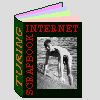
Continue to the next Scrapbook page.
|
|
|